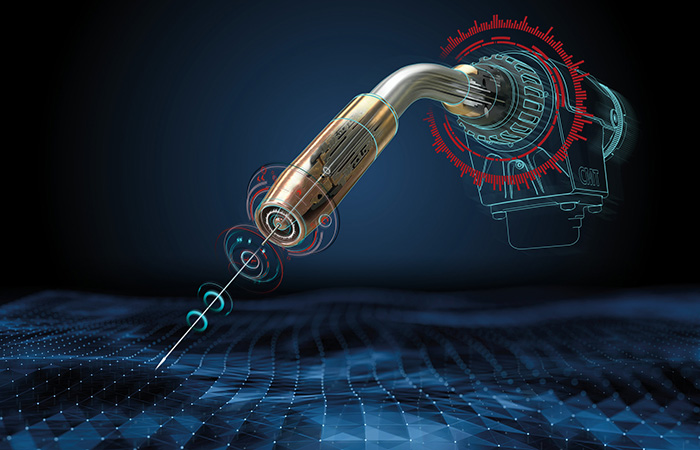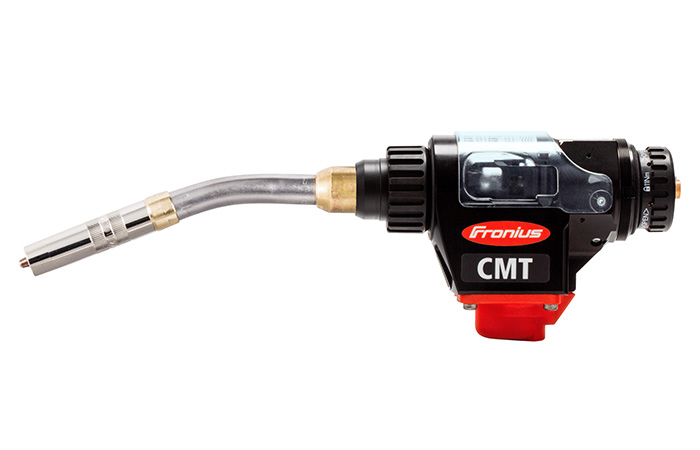
WireSense is the assistance system from Fronius which makes robotic welding more efficient. The wire electrode is turned into a sensor that checks the component position before each weld. Manufacturing inaccuracies can be compensated for and perfect welding results achieved by reliably detecting actual sheet edge heights and positions. Rework and component rejects are largely eliminated, while additional optical measuring devices become unnecessary, resulting in significant time and cost savings.
Component deviations such as varying air gaps or clamping tolerances can cause welding problems. In the worst case scenario, these deviations result in a change in the welding position and cause a lack of fusion in the weld seam. For this reason, many manufacturing companies use optical measuring devices for robotic welding. Not only are they expensive but they also significantly restrict component accessibility, need regular cleaning and require additional calibration between the Tool Centre Point (TCP) and the sensor. WireSense from Fronius offers an easier, more robust and precise alternative.

The science behind WireSense
WireSense technology does not require any additional sensor hardware components – instead the wire electrode is used as a sensor. The welding torch scans the component with a reversing wire movement and the welding system sends the height information and the edge position to the robot. For example, if a lap joint is being welded, the edge position can be precisely defined, and the system can react to any deviations. The robot adjusts the weld seam process based on an application-specific program.
By evaluating the height information, the robot can determine both the course of the edge and the actual edge height. It is also possible to determine the exact air gap between the sheets. Edges are detected from a height of 0.5 millimetres. WireSense can be used with steel, stainless steel, aluminium, and other alloys. It is with aluminium that WireSense truly comes into its own, as reflective surfaces are frequently a major obstacle for optical measuring devices.
Furthermore, optical sensors are usually installed on the robot as additional hardware where they become disruptive contours the robot arm. Depending on component accessibility, this makes the use of cameras or lasers problematic. The wire sensor does not impose any such restrictions.

An important step to adaptive robotic welding
WireSense delivers height information, which allows component contours and air gaps to be measured. During commissioning, welding parameters for different air gap sizes can be defined and saved. The WireSense assistance system therefore enables the robot to determine the actual component conditions in order to call up the suitable welding parameters. In anticipation of possible air gaps and other deviations that could lead to lack of fusion, without the use of sensors the welder often has to work at a reduced speed, in order to ensure a high weld seam quality. Thanks to the precise detection of such anomalies in advance, the robot can now join materials fully automatically at the optimal speed, which contributes to additional cycle time optimisation.
In this way, the new WireSense technology ensures that welding is always performed at the exact weld seam position with optimised parameters. Final visual inspections, rework and component rejects can be significantly reduced resulting in time savings and serious cost reductions.
Requirements
WireSense can be used with any TPS/i welding system from Fronius that is configured for the use of the CMT welding process. The precise wire movement of the Robacta Drive CMT wire feeder, which sits directly on the torch body, is crucially important. Retrofitting of existing welding systems is possible at any time due to their flexibility.










Emergency law passed to protect UK steelmaking
<b>(:-))</b> Gareth Stace as director general of trade body UK Steel, is obviously an expert on blast furnace technology & operation. Gareth...